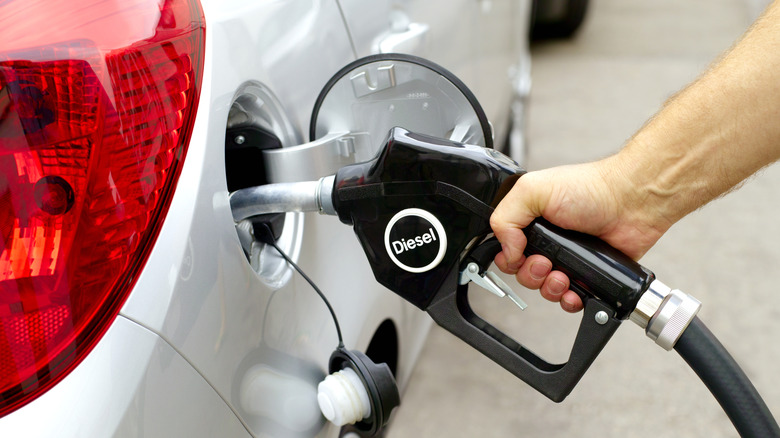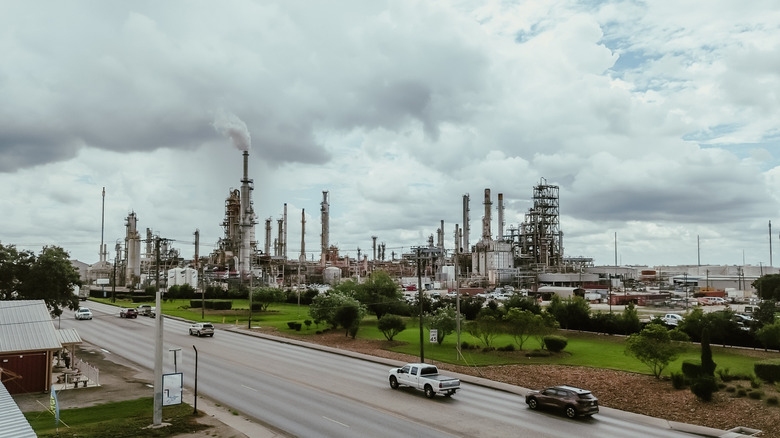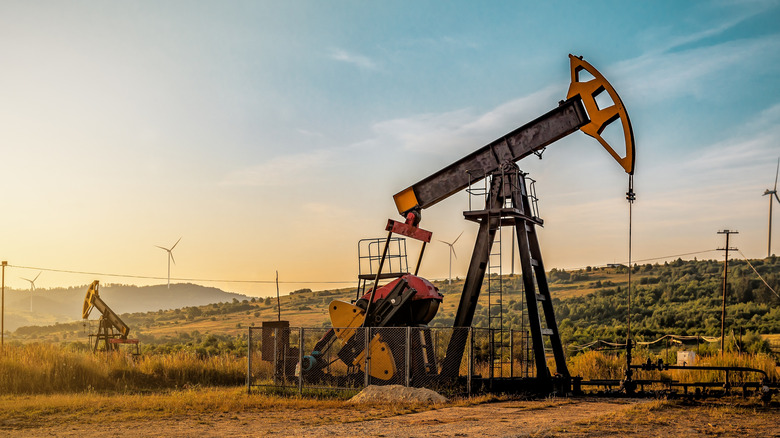How Is Diesel Fuel Made? Here's What You Need To Know
A lot of diesel vehicle drivers might take certain things about their fuel for granted. We might gripe when its price increases and reminisce about just how cheap it used to be a relatively short time ago, but there's something even more important to consider: How it came to be powering our efficient diesel engines in the first place.
Yes, you'll probably know that fossil fuels are an essential basis of gas and diesel, and you might have seen a silly dinosaur-powered bumper sticker or two to that effect over the years. There are two important things to remember, though: Firstly, fossil fuels are mostly derived from the intense underground pressure on the remains of decomposed prehistoric plants, algae, and plankton, after hundreds of millions of years. Britannica even spoils the fun by noting, "at least most of the time, you are not pouring refined dinosaur parts into the gas tank of your vehicle."
Tongue in cheek as the reference might be, it raises the vital point of refinement. What remains of the miniscule plankton that oh-so-gradually formed crude oil requires significant work before it makes its way to the pump, and the process of making diesel fuel differs quite significantly from that of making gasoline. In the case of the former, the process is called fractional distillation, and it's an invaluable way of making crude oil into a far more efficient source of fuel. Efficiency isn't the only concern, of course, as another crucial element of making diesel is keeping the process in line with today's increasingly stringent environment concerns and rules.
How fractional distillation works
Eliminating fossil fuels from the auto industry in the future is quite the tall order. As such, the first essential element of making petroleum diesel fuel, of course, is extracting it from beneath the ground. In order to do that, a source of it must be detected, and one large enough to be economically viable to pursue. As the EIA explains, smaller 'test' wells and other techniques are used to confirm the presence of the oil and whether the quantities in the area are significant, before setting up a larger scale operation of the extraction of successful seams of oil.
Once it's collected and taken to a refinery, fractional distillation is performed. Distillation and condensation are processes that, put simply, turn a liquid into a vapor and then back again. Fractional distillation is the variation of this process that allows for crude oil to begin its process of refinement. This oil is a mixture of a variety of different elements, and to make the best fuel while retaining those parts that are used in other products, the oil is processed in order to separate them.
There's one very important factor that's a huge help with this: Crude oil's constituent parts have different boiling points. This is the key to fractional distillation. In distillation towers, the elements of crude oil are heated, so diesel can be separated from the other components. Diesel, specifically, boils between 450 and 650 degrees, resulting in a distillate. It's one of the heavier products of crude oil, sporting a higher boiling point than other products such as kerosene, jet fuel (which boils between 350 and 450 degrees). Separation via their boiling points means that the condensed hydrocarbons can be easily separated, so they can be taken to where they are needed.
Further refinement is needed
The composition of crude oil, as a distinctly unpredictable natural substance, is highly variable. Its sulfur content, in particular, is vital to determine and address where necessary, because when burnt as an element of a fuel, the result is sulfur dioxide. Sulfur is always present in crude oil to a certain extent, but strict controls are necessary because sulfur dioxide is harmful to the metallic elements of a vehicle as well as the atmosphere itself more broadly. Processing to remove this harmful element is known as hydrodesulfurization, in which refineries typically cause a chemical reaction with hydrogen in order to minimize the sulfur content.
Diesel vehicles often get a bad rap, and the RAC pinpoints the Dieselgate scandal as a critical factor in this. In fact, according to the company, just 8% of new vehicles in 2023 were diesel models, compared to almost 50% just eight years prior. Cleaning up this image means cleaning up those pollutants, and just as with gas, stringent regulations along the way have contributed to a reduction in the emissions of diesel vehicles. The EIA notes that "diesel-fueled vehicles are major sources of harmful pollutants, such as ground-level ozone and particulate matter," but efforts to remedy this have paid dividends.
ULSD, or ultra-low sulfur distillate, a variety of diesel that contain no more than 15 parts per million of sulfur. The Environmental Protection Agency, since 2010, has enforced rules that mean all diesel models on highways have to use ULSD. Renewable diesel and biodiesel are two separate forms of diesel, biofuels developed from chemical reactions with sources such as animal fats or vegetable oils.


